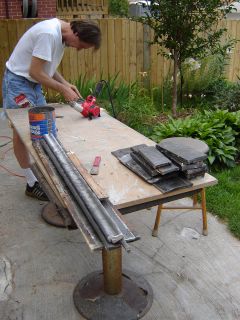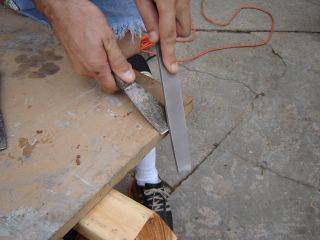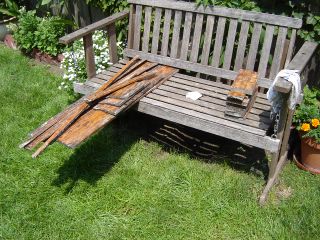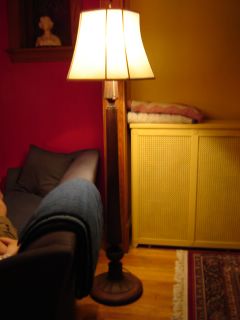I love the looks I get from people when they ask what I am doing on the weekend, and I tell them, Oh, I'll be stripping paint off wood." I wish I had a camera because it would be a very funny blog post. I mean, I don't know what their problem is, it's not like I say, "Oh, I'm just going to watch paint dry" or something like that.
As you who have done it know (and there are too many of you to mention here), removing paint from wood is a real accomplishment filled with gratification.
Some just don't seem to understand and that my friends is why we have Houseblogs! People who not only enjoy stripping paint off wood (well, kind of) but they will also read about it!
Here's my basic how-to: (Warning: If you don't want to read minutiae-stop now!)
Before I even begin stripping, I remove all nails from the boards. I use a vise grip pliers to pull them out the back to avoid damaging the wood on the front of the board. If you hammer them out from behind, it causes more damage to the wood. Sometimes the nails break off in the wood and then I get out the nail set and hammer them out until I can try the pliers again. I usually do this task the weekend before I strip the wood as I find this pretty tiring and time consuming.
First off, I set up my work area. I like to have a "dirty" board that I use as a table. I also get my work clothes and shoes on. (Steve filing my scrapers- isn't that sweet?)

Here's a list of what I gather up for this task:
2 sharpened scrapers
2 empty coffee cans for the scrapings and denatured alcohol
cloth gloves
chemical resistant gloves(which I wear under the cloth gloves)
heat gun
extension cord
stool (for sitting on)
clamps
block of wood
paint grade steel wool
Most important is to have clean sharpened scrapers.

The kind pictured are the ones that I find easiest to work with. I like a smaller scraper because I feel I have more control.

The reason you need 2 is that one is used to scrape the excess gunk off the active scraper pretty much constantly. If the scraper gets gunked up, it becomes less effective and leaves more paint residue on the board.
Say I am working on a piece of trim that has been removed. What makes this awkward is that there is nothing to push against. If it was on the wall for example, I could leverage the wall. What I do is clamp a small board to the end of my wood "table" so that I can push the trim up against it. Without the leverage it is a lot harder.
I usually heat up a 3" x 5" area of the board. It doesn't take very long maybe 30 seconds. If it starts bubbling at all, you have definitely heated it up enough. After a short time, one really gets a sense of how long it takes to heat the paint up and things move along smoothly.
As I said in a previous post, for a piece of trim about 6 feet long and 6" wide, it takes me about 35 minutes. I try to get the pieces very clean to avoid having to really scrub them with the denatured alcohol afterwards.

Boards post heat gun pre-denatured alcohol
After stripping the front and sides of the piece, I wash it down with denatured alcohol and paint grade steel wool. It seems to take a bit of elbow grease. I also scrape off any leftover paint chips at that time. Then I have a clean board that is ready to be sanded on a future date.
I used to apply stripper after heat gunning to get the residue off, but recently found out that isn't needed. Denatured alcohol does the trick, but it does take a bit more scrubbing that using chemical stripper.
There are many many posts on stripping, too bad we can't have a searchable database, but the info is there if you look for it. Hope this was helpful. When I stripped my first piece of furniture, I went to the internet in search of how-to info and I found some very good information on the subject.
I should mention that when you do stripping with a heat gun indoors on moulding that is still installed, there are many other factors to consider, including potential fire hazards. Maybe this warrants a Stripping 102 post.
For posterity: Here's the very first piece of furniture or wood I ever stripped. If you can imagine, it was painted orange probably in the 60's or 70's. I did not even stain it or anything, it had such a nice patina.

Good night housebloggers!

4 comments:
Great post! I read yours and Gary’s post about paint stripping. It’s interesting that everyone has eventually come around to very similar techniques, me included. We all tried different things but eventually ended up in the same place.
Great post- I am so glad there are other people that find stripping to be a weekend 'hobby' (or may I go so far as to call it 'entertainment'?).
My new-house friends do not understand this at all- they think I am 'working'. But, hey, I am not at the malls or movies or golfing like they are, so I am SAVING money. And to convey the joy of making something old new again is almost impossible to do with the new-house friends.
They can go on thinking I am crazy-you guys make me feel normal again-Thanks!
Great post Jocelyn! I used the heat gun for the first time this week & am learning a few tricks. Glad to hear about the denatured alcohol. I was considering chemical stripper afterwards. I'll have to for the parts of the window next to the glass. Thank you for the clear descriptions and photos!
Hmm, good tip about the second scraper. Last time I scraped I found the clever technique of banging the scraper on the bottom of my shoe ... not so sophisticated or efficient. :)
Post a Comment